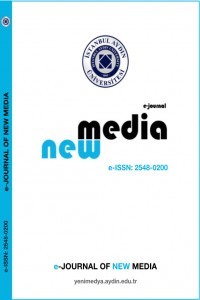MEMETİK SÜREÇLERİNE MÜDAHALE EDİLMİŞ İÇERİK: MİZAH İÇERİKLİ INSTAGRAM POSTLARININ MEM PERSPEKTİFİNDEN ANALİZİ
Kültürel aktarım birimi olarak tanımlanan mem, 90’lı yıllardan itibaren aktif bir araştırma konusu olmuştur, 2000’lerin başında ise dijital iletişim teknolojilerinin gelişimi sayesinde kullanıcı içeriklerinin dijital ekosistemin karakteristiklerinden birine dönüşmesi ile adeta ikinci baharını yaşayarak “internet memleri” adı altında gündelik hayatın bir parçası haline gelmiştir. Ancak kavramın tanımı, karakteristik özellikleri, neden bazı memler etkili olup uzun süre gündemde kalırken diğerlerinin bir anda yok olarak hafızalardan silindiği hakkında tartışmalar sonlanmamış bu konularda yeni fikirler ileri sürülmeye devam etmiştir. Bu araştırma da bu doğrultuda gelişmiş ve Türkiye’de büyük ilgi gören mizah içerikli Instagram hesaplarının mem perspektifinden incelenmesine odaklanmıştır. Söz konusu hesaplardan paylaşılan postlar aynı memler gibi kişiler arasında hızla yayılmakta, kendine has bir mizah anlayışı sergilemekte ve birden çok katmanın bir araya getirilmesi yani remiks yöntemi ile oluşturulmaktadır. Çalışma kapsamında en çok takipçisi olan 3 adet mizah hesabı seçilerek, bu hesapların paylaşımları memetik bakış açısıyla incelenmiştir. Paylaşımların bir mem üretim yöntemi olan remiks pratiği aracılığıyla üretilme süreçleri analiz edilerek bu uygulamalar hakkında bilgi edinmek amaçlanmış ve bu içeriklerin mem olarak nitelendirilip nitelendirilemeyeceği sorusu cevaplanmaya çalışılmıştır. Uygulanan tanımsal ve çıkarımsal analizler sonucunda postların mem olarak değil “memetik süreçlerine müdahale edilmiş içerik” (memetically modified content) olarak adlandırılması önerilerek bu alandaki literatüre katkı sağlanmış ayrıca çalışma Türkiye’de mem ve remiks konularında yapılmış ilk doktora araştırması olmuştur.
Anahtar Kelimeler:
Mem, İnternet Memi, Remiks, Memetik Süreçlerine Müdahale Edilmiş İçerik, Sosyal Medya Platformları
MEMETICALLY MODIFIED CONTENT: AN ANALYSIS OF THE HUMOROUS INSTAGRAM ACCOUNTS FROM THE PERSPECTIVE OF MEMETICS
The meme, defined as a cultural transmission unit, has been an active research topic since the 90s, but in the early 2000s, as a consequence of the developments in digital communication technologies, it received a new face and thus the phenomenon of “Internet memes” was born. However, debates on the definition and characteristics of memes have never reached a conclusion and the question of why some memes are more effective and circulate for a long time while others disappear and are forgotten quickly remains unanswered. Keeping these issues in mind, this research is designed within the framework of memes and remix practices and focuses on the humorous Instagram accounts of Turkey. The posts of these accounts share a number of features with memes, both are circulated rapidly among social media users, have their unique sense of humor and are instances of remixed content in other words they are composed of multiple elements. The remix practices on these posts have been investigated to shed light on the remix processes on social media platforms and answer the question of whether these posts can be considered memes. Descriptive and inferential analyzes have been conducted on 504 posts. Since it was seen that these posts distinguish from memes, the concept of “MMC (memetically modified content)” has been suggested to identify these posts. In addition to the introduction of the concept of MMC to literature, the research has a contribution to the field of digital culture as the first PhD research on memes and remix practices in Turkey.
Keywords:
Mem, İnternet Memi, Remiks, Memetik Süreçlerine Müdahale Edilmiş İçerik, Sosyal Medya Platformları,
___
- Altunışık, R., Coşkun, R., Bayraktaroğlu, S., & Yıldırım, E. (2010). Sosyal Bilimlerde Araştırma Yöntemleri. Sakarya: Sakarya Yayıncılık.
- Blackmore, S. (2011). Mem Makinesi. İstanbul: Alfa.
- Börzsei, L. (2013). Makes A Meme Instead: A Concise History of Internet Memes. New Media Studies Magazine(7), 152-189.
- Brodie, R. (2014). Akıl Virüsü. İstanbul: Pegasus.
- Church, S. H. (2015). A Rhetoric of Remix. E. Navas, O. Gallagher, & X. Burrough içinde, The Routledge Companion to Remix Studies. New York: Routledge.
- Dawkins, R. (2018). Genişlemiş Fenotip. İstanbul: Alfa.
- Dawkins, R. (2019). Gen Bencildir (40. Yıldönümü Basımı b.). Istanbul: Kuzey Yayınları.
- Dennett, D. (1999, 02 16). The Evolution of Culture. Edge.org: https://stage.edge.org/conversation/theevolution-of-culture adresinden alındı
- Dennett, D. C. (1990). Memes and the Exploitation of Imagination. The Journal of Aesthetics and Art Criticisim, 2(48), 127-135.
- Goriunova, O. (2014). The Force of Digital Aesthetics: on Memes, Hacking and Individuation. The Nordic Journal of Aesthetics, 54-75.
- Heylighen, F. (1999). What Makes a Meme Successful? Selection Criteria for Cultural Evolution. 15th International Congress on Cybernetics (s. 418-423). Namur : Association International de Cybernétique.
- Heylighen, F., & Chielens, K. (2009). Evolution of Culture and Memetics. R. A. Meyers içinde, Encyclopedia of Complexity and System Science. Springer.
- Karaaslan, P. (2020). Sosyal Medyada Kullanılan Caps’lerin Telif Hukuku Boyutu ve Yasal Düzenlemelerin Yeterliliği. Ankara Hacı Bayram Veli Üniversitesi Hukuk Fakültesi Dergisi, 3, 41-65.
- Knobel, M., & Lankshear, C. (2007). Online Memes, Affinities and Cultural Production. M. K. Lankshear içinde, A New Literacies Sampler (s. 199-229). New York: Peter Lang.
- Lessig, L. (2008). Making Art and Commerce Thrive in the Hybrid Economy . London: Bloomsbury.
- Manovich, L. (2015). Remix and Remixability. CMUEMS: http://cmuems.com/2015b/wpcontent/uploads/2015/08/Manovich-Remix-and-remixability.pdf adresinden alındı
- Markham, A. (2013). Remix Cultures, Remix Methods: Reframing Qualitative Inquiry for Social Media Contexts. N. Denzin, & M. D. Giardina içinde, Global Dimensions of Qualitative Inquiry (s. 63-82). New York: Routledge.
- Meikle, G. (2016). Social Media: Communication, Sharing and Visibility . New York: Taylor& Francis.
- Moritz, E. (1990). Memetic Science: 1- General Introduction. Journal of Ideas, 1(1), 03-23.
- Shifman, L. (2014). Memes in Digital Culture. Cambridge: MIT Press.
- ISSN: 2548-0200
- Başlangıç: 2017
- Yayıncı: İstanbul Aydın Üniversitesi
Sayıdaki Diğer Makaleler
DİJİTAL OYUNLARI İZLEMEK: PUBG MOBILE VİDEO YORUMLARINDA MOTİVASYONLAR VE ETKİLENİMLER
YOUTUBER FİLMLERİNDE ÜRÜN YERLEŞTİRME: KAFALAR KARIŞIK FİLMİ ÖRNEĞİ
TELEVİZYON DRAMALARININ SOSYAL MEDYA PERFORMANSLARINA YÖNELİK KARŞILAŞTIRMALI BİR ANALİZ
İNTİHAR OLGUSU VE MEDYA İLİŞKİSİ: ENES KARA İNTİHARININ HABER SİTELERİ ÜZERİNDEN İNCELENMESİ
